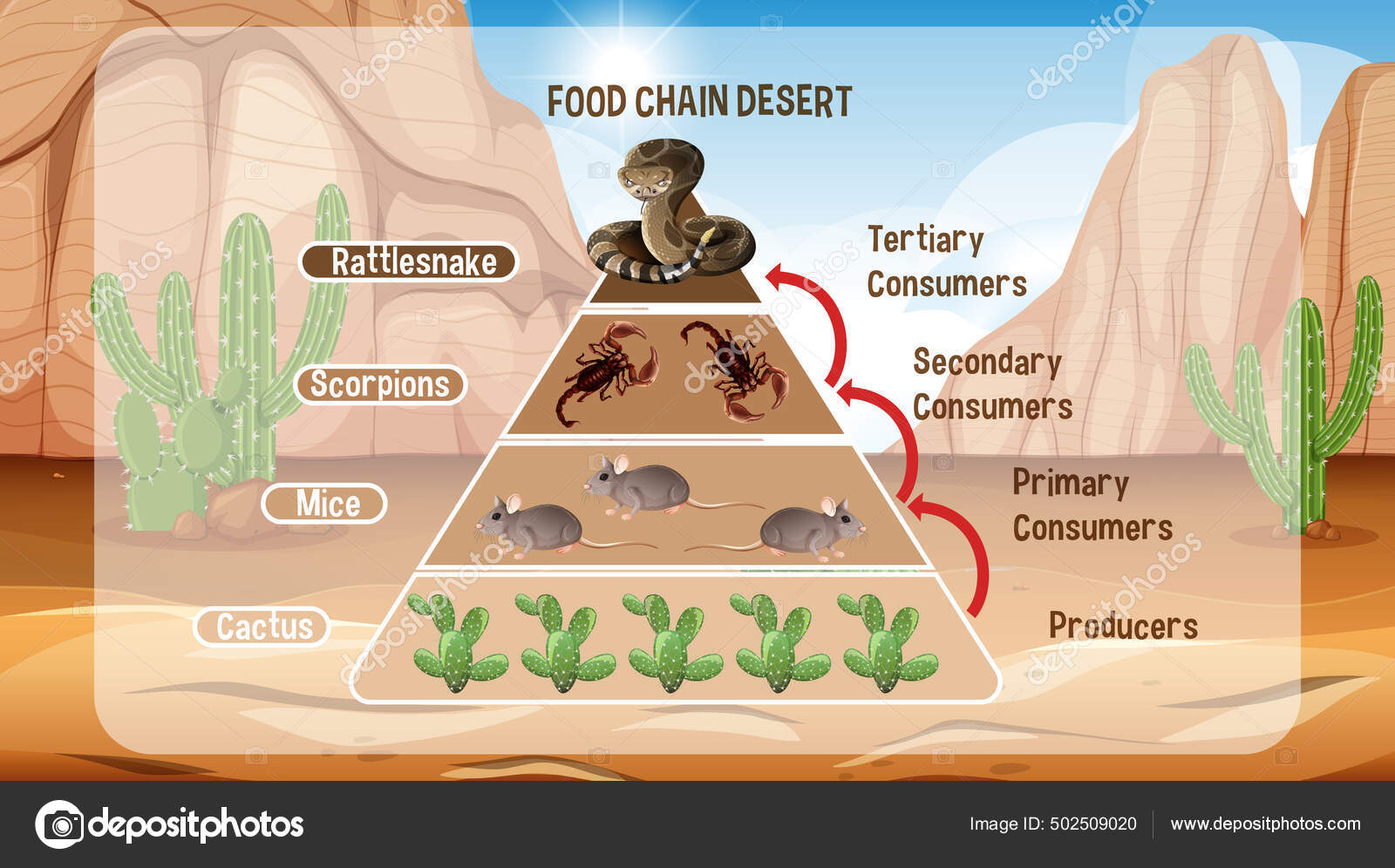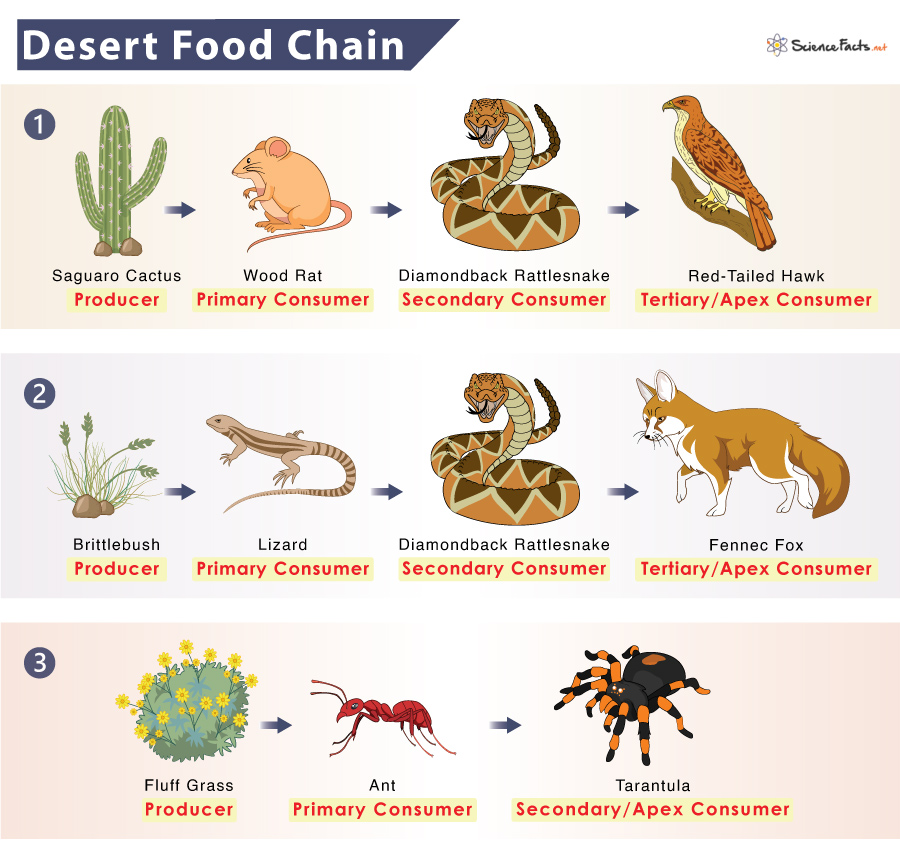Within the coronary heart of arid areas lies a charming ecosystem the place life adapts and thrives in extraordinary methods. Delving into the meals chain for desert, we uncover an interesting internet of interdependence and resilience that sustains this distinctive setting.
From the smallest bugs to the majestic predators, every organism performs a vital function in sustaining the fragile stability of the desert ecosystem.
Desert Meals Chain Construction
The desert meals chain, not like different ecosystems, reveals a singular construction because of the shortage of water and restricted vegetation. It contains varied trophic ranges, every enjoying a vital function in sustaining the fragile stability of the desert ecosystem.
Producers
The inspiration of the desert meals chain lies with the producers, primarily vegetation and sure microorganisms. These organisms harness daylight by way of photosynthesis, changing it into energy-rich compounds that function the first supply of sustenance for all different organisms within the desert ecosystem.
Major Shoppers
Major shoppers are herbivores that feed immediately on the producers. These embody bugs, rodents, and reptiles. By consuming vegetation, they acquire the required vitamins to maintain themselves and supply an important hyperlink between producers and better trophic ranges.
Secondary Shoppers
Secondary shoppers are carnivores that prey on major shoppers. Examples embody snakes, birds, and small mammals. They play a vital function in regulating the populations of herbivores, stopping overgrazing and sustaining the stability of the desert ecosystem.
Tertiary Shoppers
Tertiary shoppers are apex predators that occupy the very best trophic degree. These embody giant carnivores resembling coyotes, wolves, and eagles. They play a vital function in controlling the populations of secondary shoppers and guaranteeing the soundness of the desert ecosystem.
Decomposers
Decomposers, resembling micro organism and fungi, are important for nutrient biking within the desert ecosystem. They break down lifeless organisms and natural matter, releasing important vitamins again into the soil, which might then be utilized by producers.
Diversifications for Survival

Within the harsh desert setting, vegetation and animals have developed outstanding variations to outlive the acute situations. These variations allow them to acquire meals and water in a panorama the place sources are scarce.
Plant Diversifications, Meals chain for desert
- Succulence:Desert vegetation retailer water of their fleshy stems and leaves, permitting them to face up to lengthy intervals of drought.
- Deep Root Methods:Vegetation develop in depth root techniques that attain deep into the bottom, accessing water sources unavailable to shallow-rooted species.
- Thick Cuticles:Leaves and stems are coated with a thick cuticle that reduces water loss by way of evaporation.
- CAM Photosynthesis:Some desert vegetation use CAM (Crassulacean Acid Metabolism) photosynthesis, which minimizes water loss by opening their stomata at night time to soak up carbon dioxide.
Animal Diversifications
- Nocturnal Exercise:Many desert animals are nocturnal, avoiding the extreme warmth and water loss through the day.
- Water Conservation:Animals have environment friendly kidneys and produce concentrated urine to attenuate water loss.
- Behavioral Diversifications:Animals search shelter below rocks or in burrows to flee the solar and preserve water.
- Environment friendly Foraging:Desert animals have specialised diets and feeding methods to maximise meals consumption whereas minimizing power expenditure.
Vitality Movement and Nutrient Biking
The desert meals chain, like all ecosystems, depends on the switch of power and biking of vitamins to maintain its delicate stability. Understanding this move and biking is essential for comprehending the desert’s ecological dynamics.
Vitality, initially captured by producers by way of photosynthesis, flows by way of the meals chain as organisms devour one another. Major shoppers, resembling herbivores, acquire power by feeding on producers. Secondary shoppers, like carnivores, devour major shoppers, and so forth. With every switch, power is misplaced as warmth, leading to a gradual lower in power availability at increased trophic ranges.
Nutrient Biking
Nutrient biking entails the transformation and motion of important parts throughout the ecosystem. Producers soak up vitamins from the soil and environment, that are then handed up the meals chain by way of consumption. Decomposers, resembling micro organism and fungi, break down lifeless organisms and natural matter, releasing vitamins again into the soil.
This course of ensures a steady provide of vitamins for plant progress and first manufacturing.
Elements Affecting Vitality and Nutrient Availability
- Local weather:Temperature and precipitation patterns affect plant progress and nutrient availability. Excessive warmth and drought can cut back plant productiveness, impacting power move and nutrient biking.
- Soil Situations:Soil high quality impacts nutrient availability for vegetation. Nutrient-poor soils restrict plant progress, lowering power move and nutrient biking.
- Human Actions:Land use adjustments, grazing, and air pollution can disrupt nutrient biking and power move, affecting the soundness of desert ecosystems.
Interdependence and Symbiosis
The desert meals chain is a fancy internet of interactions between organisms, the place interdependence and symbiosis play essential roles in sustaining the soundness and resilience of the ecosystem.
Symbiotic relationships within the desert meals chain may be categorized into three most important varieties: mutualism, commensalism, and parasitism.
Mutualism
- Desert vegetation and pollinators:Desert vegetation depend on pollinators, resembling bugs and birds, to switch pollen between flowers, enabling copy. In return, pollinators profit from the nectar and pollen offered by the vegetation as a meals supply.
- Ants and acacia bushes:Ants construct nests within the hole thorns of acacia bushes, defending them from herbivores. The ants additionally feed on the nectar produced by the bushes, whereas the bushes profit from the ants’ safety.
Commensalism
- Mistletoe and desert bushes:Mistletoe vegetation develop on the branches of desert bushes, utilizing them as help. The mistletoe doesn’t hurt the bushes, but it surely advantages from the daylight and vitamins accessible within the tree’s cover.
- Rodents and burrow-dwelling animals:Rodents dig burrows within the desert, which give shelter for different animals, resembling lizards and snakes. The rodents don’t profit from the presence of those animals, however the latter profit from the shelter offered by the burrows.
Parasitism
- Fleas and desert animals:Fleas are exterior parasites that feed on the blood of desert animals. The animals endure from the lack of blood and may turn into weakened or diseased, whereas the fleas profit from the vitamins obtained from their hosts.
- Tapeworms and desert predators:Tapeworms are inner parasites that reside within the digestive tracts of desert predators. They soak up vitamins from the predators’ meals, inflicting malnutrition and well being issues within the host animals.
Disturbances and Resilience

Desert meals chains, like all ecosystems, face varied disturbances that may alter their construction and dynamics. Understanding these disturbances and the resilience mechanisms that allow the desert meals chain to get better is essential for its conservation and administration.
Sorts of Disturbances
- Local weather variability and extremes:Deserts expertise excessive temperature fluctuations, droughts, and floods, which might affect plant and animal survival.
- Human actions:Land use adjustments, habitat fragmentation, and air pollution can disrupt meals chains by altering habitat availability and useful resource abundance.
- Invasive species:Non-native species can compete with native species for sources, resulting in inhabitants declines and ecosystem disruption.
- Fireplace:Wildfires can burn vegetation, destroying habitat and meals sources for animals.
- Illness outbreaks:Pathogens can unfold quickly by way of desert populations, inflicting important mortality and disrupting meals chains.
Impression on Ecosystem Construction and Dynamics
Disturbances can affect desert meals chains in a number of methods:
- Altered species composition:Disturbances can favor sure species over others, resulting in adjustments in group construction.
- Decreased biodiversity:Excessive disturbances can lead to species extinctions and a decline in total biodiversity.
- Disrupted power move:Disturbances can disrupt power switch between trophic ranges, affecting the provision of meals sources.
- Altered nutrient biking:Disturbances can have an effect on nutrient availability and biking processes, impacting plant progress and animal well being.
Resilience Mechanisms
Regardless of these disturbances, desert meals chains exhibit resilience, enabling them to get better and keep ecosystem operate. Key resilience mechanisms embody:
- Diversifications to excessive situations:Desert species have developed physiological and behavioral variations that enable them to outlive in harsh situations.
- Seed banks and dormancy:Many desert vegetation produce dormant seeds that may stay viable for prolonged intervals, permitting them to recolonize after disturbances.
- Dispersal and colonization:Desert animals and vegetation have tailored to disperse lengthy distances, facilitating recolonization of disturbed areas.
- Mutualistic relationships:Symbiotic relationships between species, resembling pollination and seed dispersal, improve ecosystem stability and resilience.
- Ecological reminiscence:Desert ecosystems have a “reminiscence” of previous disturbances, which influences their response to future occasions.
Human Impacts: Meals Chain For Desert

Human actions have a big affect on desert meals chains. These impacts may be direct, resembling habitat loss and air pollution, or oblique, resembling local weather change.
Habitat lossis without doubt one of the most vital threats to abandon meals chains. As human populations develop, so does the demand for land for growth. This growth can result in the destruction of desert habitats, which might in flip result in the lack of meals sources for desert animals.
Air pollution
Air pollution is one other main menace to abandon meals chains. Pollution can enter the desert setting by way of a wide range of sources, together with industrial actions, agricultural runoff, and automobile emissions. These pollution can hurt desert animals immediately, or they will not directly hurt them by contaminating their meals sources.
Local weather Change
Local weather change can also be a serious menace to abandon meals chains. Because the local weather adjustments, the distribution of desert vegetation and animals is prone to change. This might result in the lack of meals sources for some desert animals, and it might additionally make it tougher for them to search out mates.
Mitigating these impactsis important for conserving desert ecosystems. There are a selection of issues that may be carried out to mitigate the impacts of human actions on desert meals chains, together with:
- Defending and restoring desert habitats
- Lowering air pollution
- Addressing local weather change
Useful Solutions
What are the important thing variations that allow organisms to outlive in desert situations?
Organisms within the desert have developed outstanding variations, resembling water storage mechanisms, specialised feeding habits, and physiological variations to preserve water and power.
How does the move of power by way of the desert meals chain affect nutrient availability?
The move of power by way of the meals chain determines the provision of vitamins, as producers convert daylight into power and shoppers make the most of these vitamins for progress and copy.




